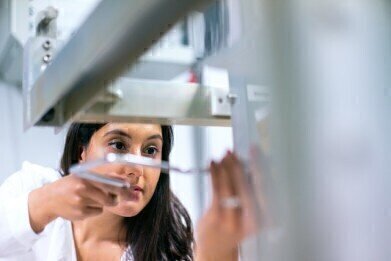Chromatography
What's the Difference Between PSA and Membrane Nitrogen Generators?
Jun 15 2022
All nitrogen gas generators are designed to produce pure, high-quality gas for laboratory applications. However, there are variations between models. Below, we explain the key differences between PSA and Membrane Separation nitrogen generators.
First, let’s take a look at how each type of generator produces nitrogen.
Membrane Separation generators
Membrane Separation gas generators use compressed air to produce high-quality nitrogen. Every device features a built-in separation membrane made up of thousands of hollow, permeable fibres. As compressed air passes through the membrane, ‘fast’ gases such as oxygen and CO2 travel through the fibres faster than nitrogen, which is a ‘slow’ gas. The purified nitrogen is captured and can then be used for laboratory applications.
Pressure Swing Adsorption (PSA) Generators
Like Membrane Separation generators, PSA systems generate lab-quality nitrogen using compressed air. A porous Carbon Molecular Sieve (CMS) is used to capture oxygen from compressed air and allow larger nitrogen molecules to filter through. To prevent the CMS from becoming soaked with oxygen molecules, PSA generators feature two columns. One continually separates gas while another is cleansed with ultra-pure nitrogen. This ensures operators have access to a reliable and constant stream of nitrogen.
PSA vs Membrane Separation technology
There are three main differences between PSA and Membrane Separation technology, explored in more detail below:
-
Purity
Purity is the main differentiator when it comes to PSA vs Membrane Separation technology. PSA generators are gold-standard and can produce nitrogen with purity levels as high as 99.9995%. This makes them the generator of choice for applications where purity is a priority. Nitrogen Separation Membrane generators also offer exceptional quality, though not as high as PSA systems. The devices can achieve purity levels of 99.5%.
-
Reliability
Membrane Separation gas generators are the simplest of the two technologies. Devices have very few moving parts which minimises the risk of failure. PSA generators produce exceptionally pure nitrogen though they rely on components such as valves, adsorption beds, buffer tanks, control panels and multiple columns. This means they generally require more maintenance.
-
Convenience
Both PSA and Membrane Separation gas generators are easy to operate and require very little training. In terms of size, Membrane Separation generators are usually more compact and desktop friendly. PSA generators tend to have a larger footprint due to the more sophisticated technology.
From preserving highly sensitive active ingredients used in drug discovery labs to controlling environmental conditions in IVF incubators, nitrogen is used across a wide range of sectors and industries. Find out more about the benefits of nitrogen gas generators, as well as devices such as hydrogen gas generators, zero air generators and Total Organic Carbon (TOC) generators, in our complete guide, ‘Laboratory Generators - Everything You Need to Know’. Or check out 'Optimising Bioreactor Yields with Smart Sensors' for more on the latest laboratory developments.
Digital Edition
ILM 49.5 July
July 2024
Chromatography Articles - Understanding PFAS: Analysis and Implications Mass Spectrometry & Spectroscopy Articles - MS detection of Alzheimer’s blood-based biomarkers LIMS - Essent...
View all digital editions
Events
Jul 28 2024 San Diego, CA USA
Jul 30 2024 Jakarta, Indonesia
Jul 31 2024 Chengdu, China
ACS National Meeting - Fall 2024
Aug 18 2024 Denver, CO, USA
Aug 25 2024 Copenhagen, Denmark




24_06.jpg)













